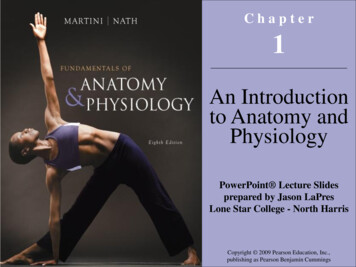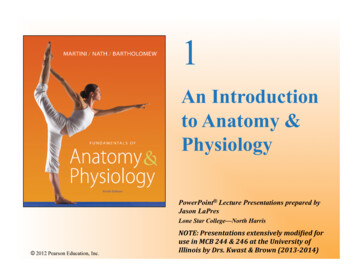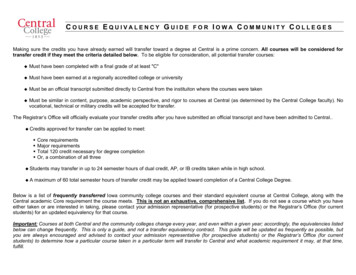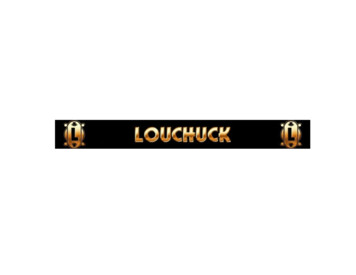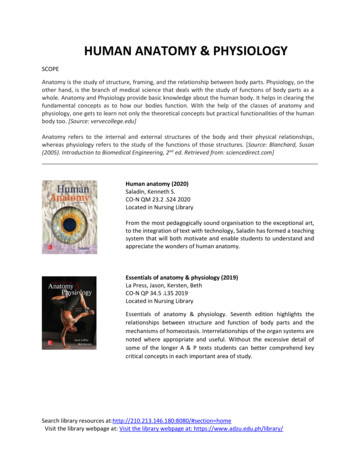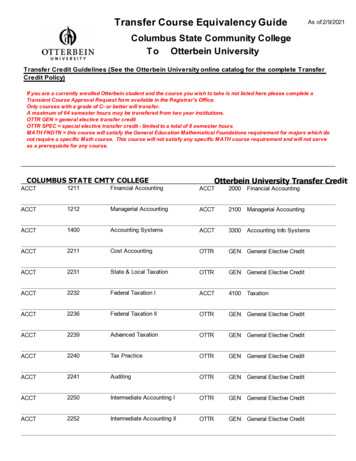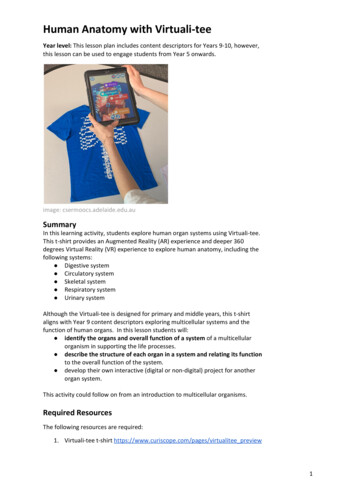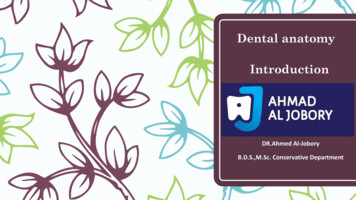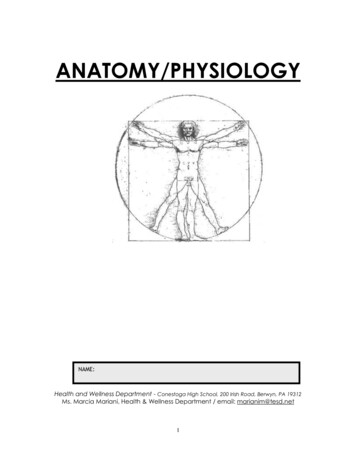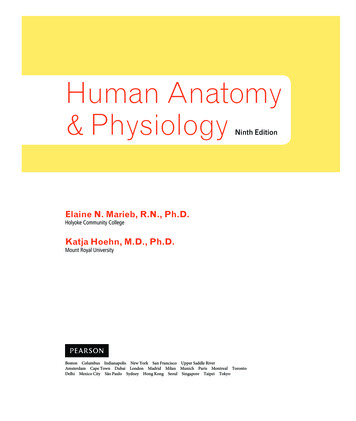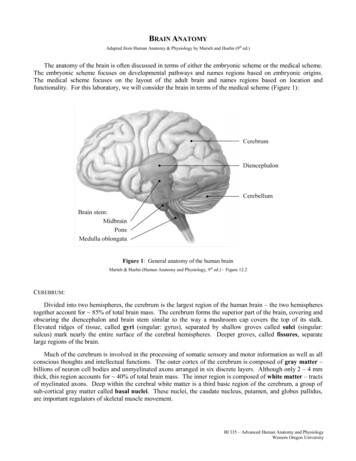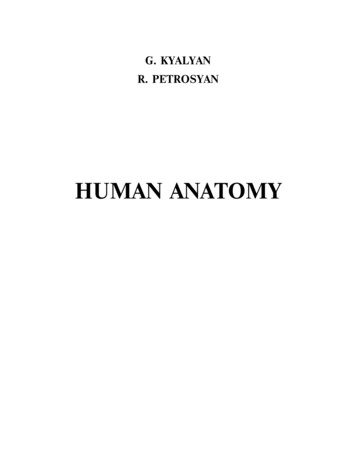
Transcription
G. KYALYANR. PETROSYANHUMAN ANATOMY
Adapted course for foreign studentsVolume IThe weight-bearing and locomotor systemYerevan 2000
INTRODUCTIONTHE SCIENCE OF HUMAN ANATOMYThe science of human anatomy is the study of the form and structure of thehuman body (and the organs and systems which form it) and the regularities of thedevelopment of this structure in relation to its function and external environment.The study of anatomy previously dealt with a single problem: how the body isbuilt.The object of the old descriptive anatomy was description of the structure of thebody. In modern anatomy, however, description is a means rather than an end, one ofthe methods used the studying the human body structure. This method gives modernanatomy its descriptive aspect. Modern anatomy, however, attempts to explain not onlyhow the organism is formed, but why it is so formed. To answer this second question,it is necessary to investigate both internal and external relationships of the organism.Anatomy, therefore, studies not only the structure of the modern adult humanbeing, but investigates the human organism in its historical development. With this inmind, the following three points shut be considered.1. The development of the human genus in relation to the evolutionary processof the lower life forms. This study is called phylogenesis (Gk. phylon genus, genesisdevelopment) and uses the data of comparative anatomy, which compares thestructures of various animals and man.2. The formation and development of the human being in relation to thedevelopment of society. The study of anthropogenesis (Gk. anthropos human being),which uses the findings of both comparative anatomy and evolutionary morphology, isbased primarily on the data of anthropology, the scientific study of mankind in itsdevelopment. A branch of anthropology known as anatomical anthropology studies thestructure of the human body not in relation to a hypothetical “average” human beingbut in relation to a given group of people who may vary according to constitution,occupation, and way of life.3. The process of the development of the individual organism throughout life.Ontogenesis (Gk. anthos being) is concerned with uterine, embryonal (embryogenesis)processes, and extrauterine, postembryonal or postnatal (L post after, natus birth)
processes. The data of embryology (Gk. embryo to grow) and age anatomy are used inthe study of ontogenesis. The last period of ontogenesis, ageing, is the subject ofgerontology, the study of the ageing process (Gk. geron, gerontos old man). Individualand sexual differences in the shape, structure, and position of the body and its organsas well as the topographic relationships of the organs are also taken into account.The study of human anatomy is conducted not simply in and of itself. It is ratherbased on the principle of the unity of theory and practice and has an applied aspectwhich serves both medical science and physical culture.In view of the vast material involved and the difficulty of studying the organismas a single entity, it is at first examined according to systems. The approach ofsystematic anatomy is to divide the organism artificially into parts using the analyticalmethod. In the living organism, however, the separate parts and components of thebody’s structure (its systems, organs, tissues and so on) are not isolated but related inorigin and development, and each helps shape and form the others.Besides systematic anatomy there is topographic or regional anatomy whichstudies the spatial relationships of the organs in the different body regions. Sincetopographic anatomy has direct, practical significance for clinical work, particularly insurgical practice, it is also called surgical anatomy. Some authors separate fromtopographic anatomy an aggregate of information concerning the external relief of thebody and its regions under the term “relief” anatomy.Applied anatomy for artists and sculptors studies only the external form andproportions of the body and is known as plastic anatomy.Anatomy that studies the normal healthy organism is called normal anatomy, asdistinct from pathological, or morbid, anatomy, which is concerned with the study ofthe sick organism and the morbid changes in its organs.Study of the anatomy of the living human being is especially necessary for thephysician. The successes of this branch of anatomy are linked with advanced in X-raymethods of examination which allow physicians to view almost all the organs andsystems of the living human organism and constitute an integral part of that branch ofmodern anatomy designated as X-ray anatomy.All these branches of anatomical science are different aspects of a single human
anatomy.The relationships existing in a single organism can be understood only bycomparing the anatomical data with the data of other, related disciplines.Man is the high point in the development of living matter. To understand thehuman structure, therefore, it is necessary to use the data of biology, the science of thelaws of the origin and development of living matter. Just as man is a part of nature,anatomy, the science studying man’s structure is part of biology.The unity of form and function in the structure of the organism. The organismand its components – organs, tissues, and cells – are different types of matter.To understand the structure of the organism in light of the connection betweenform and function, anatomy uses the data of physiology, the science of the organism’svital function. Biology is usually separated into two branches: morphology, the studyof form, and physiology, the study of function.Since the external shape of organs cannot be separated from their internalstructure, anatomy is also related closely to histology, the science of tissues, particularlyto the branch of histology known as microscopic anatomy. Macroscopic, or gross,anatomy (Gk. markos large, skopein to watch) and microscopic (Gk. micros small)anatomy are in essence a single science divided into two branches according toexamination technique.With the invention of the electron microscope, it became possible to examinesubmicroscopic structures and even molecules of living matter, which are also theobjects of study in chemistry. A new science, cytochemestry was born at the junctionof cytology and chemistry. As a result the structure of the human organism is nowstudied at different levels:1. At the level of systems and organs: (a) with the naked eye—macroscopic, orgross, anatomy; (b) with a magnifying glass—micro-macroscopic anatomy; (c) with amicroscope—microscopic anatomy.2. At the level of tissues (histology): (a) with a magnifying glass;(b) with a microscope.3. At the cellular level (cytology): (a) with a light microscope; (b) with anelectron microscope.
4. At the molecular level: (a) with an electron microscope and by means of cytohistochemical reactions.Thus, anatomy and histology are currently divided according to level andtechnique of examination.Anatomy, histology, cytology, and embryology constitute the general science ofthe form, structure, and development of the organism, which is called morphology (Gk.morphe form, shape).METHODS OF ANATOMICAL STUDY.There are two principal methods of anatomical study.1. Examination of a cadaver by opening the body cavities and dissecting theorgans and tissues with surgical instruments. The science of anatomy derives its namefrom this procedure of dissecting the whole cadaver into parts (Gk. anatome todissect). Tubular systems (vessels, ducts, and so forth) are injected with various media(injection method) and then exposed to X-rays, clarification, or corrosion. Nerves aretreated by elective staining.2. Examination of a living human being. Every physician begins examination ofa patient with this procedure, which includes palpation, percussion, auscultation,various measurements of the body (anthropometry), and endoscopy examination of thehollow organs through the natural body orifices (Gk. endon within).X-rays provide the best possibilities for studying "living anatomy". They open, asit were, the internal organs of a living human being without a knife and without, painand make it possible to observe the structure of the organs of a single individualthroughout, the course of his life (X-ray anatomy). X-rays are used for making X-rayphotographs (radiography) and for visualization on a special screen (radioscopy).The newest methods of X-ray examination are as follows:1. Electroradiography produces an X-ray image of the soft tissues (skin,subcutaneous fat, ligaments, cartilages, the connective tissue framework of theparenchymatous organs, etc.) which are invisible on ordinary radiographs because theyare radiolucent.2. Computer tomography produces an image of all the organs in a single plane
of body tissue, much like sections of a frozen cadaver prepared according to the methoddeveloped by N.I. Pirogoff.In addition, experimental anatomy, in which experiments are performed onanimals, is an important method of anatomical research.As can be seen, modern anatomy has at its disposal a rich store of means forstudying the structure of both the dead and the living human body.THE STRUCTURE OF THE HUMAN BODYTHE ORGANISMSince the object of study in anatomy is the organism, we shall first give a generalaccount of its structure.The organism is the highest form of unity of protein bodies capable of exchangingsubstances with the environment and of growing and multiplying. The organism is ahistorically formed, integral, continuously changing system with a specific structureand developmental pattern. The organism lives only under definite environmentalconditions to which it is adapted and beyond which it cannot exist. Continuousexchange of substances with the environment is an essential feature of the organism'slife.THE ORGANISM AND ITS COMPONENTSThe organism is built of separate individual structures, i.e. organs, tissues, andtissue components united into a whole.In the process of the evolution of living substances, first the noncellular forms(protein moners, viruses, and so on) and later the cellular forms {unicellular and thelowest multicellular organisms) developed.In the human organism, just as in the organism of all other multicellular animals,the cells exist only as components of the tissues.TissuesTissues are historically formed, individual systems of the organism.They are composed of cells and their derivatives and possess specificmorphophysiological and biochemical properties.
Each tissue is characterized by development, from a definite embryonal bud inontogenesis, by relationship to the other tissues, and by a particular location in theorganism. Tissues are formed morphologically of cells and an intercellular substance.The great variety of tissues in the human and animal organism may beconditionally divided into four groups: (1) the integumentary tissues, or the epithelium(Gk. epi upon, L tela, tissue fine as a web); (2) tissues of the organism's internalenvironment, or connective tissues; (3) muscular tissues, and (4) neural tissues.The integumentary, or epithelial tissues are located on surfaces bordering theexternal environment (hence the name skin-type epithelium given to some of them)and form the lining of the hollow organs (intestinal-type epithelium) and closed cavitiesof the body (cellonephrodermal- and ependymoglial-type epithelium). Epitheliumlining the vessels is called endothelium. Complexes of epithelial cells in the shape oftubes, saccules, and other structures form glands (glandular epithelium). The mainfunctions of epithelium are tegumentary and secretory.Tissues of the internal environment, or connective tissues. These tissues areisolated from the external environment, they differ greatly in properties and are joinedin one group on the basis of a common function (which also determines the main signsof their structure), the maintenance of homeostasis.The tissues of the internal environment developed in three main directions: onesubgroup became concerned with tropic and protective functions (fluid tissues, theblood and lymph, and the haemopoietic tissues), another group with the supportingfunction (fibrous connective and skeletal tissues), and a third group with thecontractility function (mesenchymal-type unstriated muscular tissue).Contractile tissues, muscular tissues, are grouped together according to thefunctional property, the ability to contract.The smooth, unstriated, or involuntary muscular tissue contracts slowly andconsists of spindle-shaped or stellate cells containing fine threads, microfilaments. Theskeletal (somatic) muscular tissue consists of long (up to 10-12 cm in length) fibresmeasuring only 10-15 m in diameter. The fibrils also contain specific elements in theform of cross striated myofibrils possessing, in turn, a submicroscopic structure. Themuscular tissue of the heart is made up of separate cells containing cross striated fibrils
differing in some details of their structure from the fibrilis of the skeletal muscularfibres.Neural tissues are made up of nerve cells and auxiliary elements, neuroglia, or,in short, glia (Gk. glia glue). The nerve cells are supplied with processes of two types:(1) those which convey the stimulus from the perceiving apparatus to the body of thecell and which branch freely, that is why they are called dendrites (Gk. dendron tree)and (2) those which arise, each one separately, from the body of the cell and conveythe nerve impulse from it to the effector cell which exerts the effect. This process iscalled the neurite; it stretches for a long distance, sometimes for more than 1 m, andforms the axial cylinder of the nerve fibre and is therefore also called an axon (L axis).The axon may be covered with a myelin sheath of special cells of the neuroglia.According to the details of their structure, white medullated (myelinated) and greynon-medullated (non-myelinated) fibres are distinguished. A nerve cell with all itsprocesses and their end branchings is called a neuron (Gk. neuron nerve).ORGANSAn organ (Gk. organon tool, instrument) is the part of the human body thatserves as an instrument for the adaptation of the organism to the environment.An organ is a relatively integral structure which has a definite, inherent only in it,form, structure, development, and position in the organism. It is a historically establishedsystem of different tissues (often of all the four main tissues) one or more of whichprevail and determine its specific structure and function. The vital activity of the organoccurs under the direct effect of the nervous system.The heart, for instance, is made up not only of cardiac muscular tissue but ofdifferent types of connective tissue (fibrous, elastic), elements of the nervous system(cardiac nerves), endothelium, and unstriated muscle fibres (vessels). The cardiacmuscular tissue prevails, however, and it is exactly its property (contractility) thatdetermines the structure and function of the heart as an organ of contraction.Permanent (definitive) organs, i.e. those characteristic of an adult organism andpersisting throughout life and temporary (provisional) organs which appear in a certainstage of the organism's development and then disappear (e.g. some embryonal and
extraembryonal organs) are distinguished from the standpoint of the periods ofontogenesis.Some organs are made up of many structures which are similar in organizationand are themselves formed of several tissues (e.g. the nephron in the kidney). Theyare called morpho-functional units.SYSTEMS OF ORGANS AND APPARATUSSome functions cannot be accomplished by only one organ. That is why acomplex of organs, systems, form.The system of organs is a collection of homogeneous organs marked by acommon structure, function, and development. It is a morphological and functionalassemblage of organs, i.e. organs which have a common plan of structure and acommon origin and which are connected with each other anatomically andtopographically.Some organs and systems of organs differing in structure and development maybe united for the performance of a common function. Such functional collections ofheterogeneous organs are called an apparatus. The apparatus of movement, forinstance, includes, the bone system, the articulations. of bones, and the muscularsystem.The following systems of organs and apparatus are distinguished.1. Organs concerned with the principal process characterizing life, the exchangeof substances with the environment. This process is a unity of opposite phenomena,assimilation and dissimilation. That is why there are organs by means of which theorganism incorporates nutrients and oxygen and which form the digestive and therespiratory systems, and organs which excrete from the body waste substances that havebecome unfit for use; these make up the urinary system. Waste substances are alsoexcreted through the digestive and respiratory organs and the skin.2. Organs concerned with the maintenance of the species, the reproductive, orsex organs; they form the genital, or reproductive system.The urinary and reproductive systems are closely related in development andstructure and are therefore united under the term urogenital system.
3. Organs by means of which substances incorporated by the digestive andrespiratory systems are distributed throughout the organism while substances whichmust be excreted are brought to the excretory system. These are the organs ofcirculation, the heart and vessels (blood and lymph vessels). They make up thecardiovascular system.4. Organs responsible for the chemical connection and regulation of all processesin the organism. These are the endocrine glands or organs; they form the endocrineapparatus.The organs of digestion, respiration, and reproduction, the urinary organs, thevessels, and the endocrine glands are grouped under the term organs of vegetative lifebecause similar functions are encountered in plants.5. Organs concerned with adaptation of the organism to the environment bymeans of movement form the motor apparatus consisting of movement levers, i.e. thebones (the bone system), their articulations (joints and ligaments), and muscles whichmake them move (the muscular system).6. Organs perceiving stimuli from the external environment make up the systemof sensory organs.7. Organs which accomplish the nerve connections and unite the function of allorgans into a single whole form the nervous system with which the higher nervousactivity (psyche) is associated. In the process of the development of the animal world,the nervous system became the main system providing the integrity of the organismand its unity with the conditions of life. It is responsible for the exchange of substanceswith the surrounding nature.ASa result the following scheme of the organism s structure can be markedout: the organism-—the system of organs—the Organ—the morpho-functional unit of theorgan—the tissue—the tissue elementsTHE MAIN STAGES IN THE INDIVIDUALDEVELOPMENT OF THE HUMAN ORGANISMAccording to the environment in which the individual is developing, the wholeontogenesis is separated into two large periods between which is the moment of birth.
1. The intrauterine period, in which the newly conceived organism develops inthe mother's womb, lasts from the moment of conception to the time of birth.2. The extrauterine or postnatal (L natus birth) period, in which the newindividual continues development outside the mother's body, lasts from the moment ofbirth until death.The intrauterine period is separated, in turn, into two phases: (1) the embryonicphase (the first two months) in which the initial development of the embryo occursand the organs are mainly laid; (2) the foetal phase (3rd to 9th months) in which thefoetus develops further.THE EXTRAUTERINE DEVELOPMENTAL PERIOD OF THE ORGANISMThe following age periods are distinguished in the life of a human after birth.1. The neonatal period (the first two or three weeks after birth) in whichthe organism must become adapted to the new conditions of extrauterine life. Thebody of the newborn differs drastically from that of an adult in shape anddimensions. The height of a newborn is 50 cm on the average and the weight3250-3500 g. The head (the cerebral part mainly) is very large and accounts for1/4 of the height (in an adult the head constitutes 1/7-1/8 of the height), the legs,in contrast, are short (1/3 of the height). The abdomen is larger than the chestand bulges foreward because the pelvis is narrow. The upper and lower limbs areapproximately equal in length.2. The suckling period (infancy) from the age of 4 weeks to 12 months.3. The period of deciduous dentition (natural infancy) from the age of 12months to 7 years, i.e. from the beginning of the eruption of the deciduous teethto the beginning of the eruption of the permanent teeth. The secondary sexcharacters, both in girls and in boys, are poorly pronounced.This period is separated into the pre-preschool (12 months to 3 years) andpreschool (3 to 7 years) periods.4. The adolescence period (bisexual childhood) lasts from the age of 7 to15-16 years, from the beginning of permanent teeth eruption to the end of theeruption of all second molars, to the beginning of puberty. The grade school age
(7-11 years) and the middle school age (12-15-16 years) are distinguished in thisperiod. The middle school age is characterized by intensified formation of secondarysex characters in both sexes and because of this the period is also known asprepuberty.5.The puberty period or juvenile (L juvenis youth) age. This period beginsat the end of eruption of the second molars and lasts till growth ceases and physicalmaturity is attained.This period lasts from the age of 13-14 to the age of 18 in girls and from the ageof 15-16 to the age of 19-23 in boys. The period between 16 and 18 years of age is alsoknown as the high school age; the middle and high school age are known together asthe teen-age period. Secondary sex characters develop during puberty, as a result ofwhich boys become young men, and girls become young women.In this period the height and body proportions come close to those of adults.Two periods of intensified growth are distinguished: at the end of natural infancy (5 to7 years of age) and during puberty (girls at the age of 11-14 years and boys at the ageof 13-16 years). Growth also continues after the onset of puberty.6. The change of the organism from the juvenile age to the adult state does notmean that development ceases. It continues but changes in the form and structure ofthe body are less marked.The following three stages are distinguished in the development of an adultorganism.1. Prime of adulthood. This stage lasts from the age of 25 to the age of 45 inmales and from 20 to 40 years of age in females.2. Maturity lasting to the time of the appearance of changes associated with oldage (attrition and loss of teeth, obliteration of the sutures of the skull).3. Old age (senium) characterized by progressive involution of the bodily organsand systems which leads to death.THE FORM, SIZE AND SEX OF THE HUMAN BODYThe human body is made up of the head (caput), neck (collum), trunk (truncus),and two pairs of limbs, or extremities, the upper (membra s. extremitates [BNA]superiores) and lower (membra s. extremitates [BNA] inferiores). The following parts are
distinguished in the head: the forehead (frons); the highest point of the skull (vertex);the back of the head (occiput); the temples (tempora) and the face (facies). The trunkconsists of the chest (thorax), the abdomen (abdomen) and the back (dorsum). Thefollowing linest are drawn for orientation on the chest surface: 1) midline (linea medianaanterior); (2) sternal line (linea sternalis) stretching along the sternal border; (3)mamillary line (linea mamillaris s. medioclavicularis) passing through the nipple or themiddle of the clavicle; (4) parasternal line (linea parasternalis) passing midway betweenthe sternal and mamillary lines; (5) anterior, (6) middle, and (7) posterior axillary lines(lineae axillarea anterior, media and posterior), the first and last passing through theanterior and posterior folds of the axilla, respectively, and the middle line passingthrough the point midway between these folds; (8) scapular line (linea scapularis)passing through the inferior angle of the scapula.The abdomen is divided by two horizontal lines, one drawn between the ends ofthe 10th ribs and the other between both the anterior superior iliac spines, into threeparts, one located above another: the upper part of the abdomen (epigastrium), themiddle part (mesogastrium) and the lower part (hypogastrium) (Fig. 1).Fig. 1 Subdivision of the abdomen into regionsEach of these three parts of the abdomen is subdivided by two vertical lines intothree secondary regions: the epigastrium is divided into a middle epigastric region (regio
epigastrica) and two lateral regions, the right and left hypochondrium (regioneshypochondriacae dextra and sinistra). The middle abdomen is divided in the samemanner into a medial umbilical region (regio umbilicalis) and two lateral, right and leftlumbar regions (regiones abdominales laterales, dextra and sinistra). Finally, thehypogastrium is divided into the pubic region (regio pubica) and two lateral, right andleft inguinal regions (regiones inguinales, dextra and sinistra). The upper limb is dividedinto the arm (brachium), the forearm (antebrachium) and the hand (manus}; the palm(palma manus), the back (dorsum manus} and the fingers (digiti manus} are distinguishedin the hand. The lower limb, in turn, is divided into the following parts: the thigh(femur), the leg (crus), and the foot (pes}, in which the sole (planta), the dorsum of foot(dorsum pedis}, and the toes (digiti pedis} are distinguished.The sex characters distinguishing a male from a female are divided into primaryand secondary. The reproductive organs, the sex glands in the first instance, whichdetermine the sex are the primary characters. All the other characters are secondary.Females are smaller in height (by 12 cm on the average) and weigh less (a femaleweighs 55 kg on the average). In relation to the body height, the trunk is shorter in afemale than in a male, but the lower limbs of a female are longer. The shoulders arenarrower in females, but the lower part of the trunk is wider because a female pelvis iswider than the pelvis of males. The chest of a female is shorter and narrower than thatof a male as a result of which, as well as because the female pelvis is inclined more tothe front, the abdomen of a female is longer. The average total bulk of muscles makesup 40 per cent of total body weight in males but only 32 per cent in females, as aconsequence the physical strength of females is in general less than that of males. Theadipose tissue is developed more copiously in females. Developed mammary glands area typical secondary sex character of females; in males these glands are rudimentary.The skin of males is thicker and coarser and, moreover, is more hairy (especially onthe face).Body length165 cmM153 cmFMF
Head trunk length77.75.172.70Trunk length1.351.51.249.05Shoulder width37.35.635.429.526.2027.488.89.281.20Upper limb length34.028.Lower limb length48.85Pelvis width782.974.74.5569.169.1CONSTITUTIONThe general concept "organism" defined above does not adequately portray thenotion of an actual individual who must be dealt with both in the study of anatomyand in the physician's practice. Closer study of individuals discloses marked differencesbetween them, both morphological and functional. These differences provided thematerial for the science of the human constitution. Constitution is the totality of thosefeatures of build which are associated with specific, mainly biochemical, peculiaritiesof the organism's vital activity. These peculiarities are manifested morphologically bythe deposit of fat and the development of the musculature, which affects the shape ofthe chest, abdomen, and back.The term constitution usually means a complex of individual physiological andmorphological features, related only to the given individual, that form under definitesocial and natural conditions and are displayed in the organism's reaction to differentinfluences (pathological among others).Despite the diversity of individual features encountered among humans, thesefeatures may nonetheless be grouped into types of constitution. Three constitutionaltypes are differentiated from the morphological standpoint (Fig. 9).1. Hypersthenic, marked by predominant growth in breadth, massive bulk, andgood nourishment. The trunk is relatively long, but the limbs are short. The head,
chest, and abdomen are very large because the corresponding body cavities are greatlydeveloped. There is relative predominance of the size of the abdomen over that of thechest and of the transverse dimensions over the longitudinal dimensions.2. Asthenic, characterized by predominant growth in length, just proportions,slenderness of body build, and poor general development. The limbs predominateover a relatively short trunk, the chest over the abdomen, and the longitudinaldimensions over the transverse dimensions.3. Normosthenic, a constitutional type intermediate between the other two.According to another classification, three types of body build are alsodistinguished.1. Dolichomorphic, marked by a body that is long or of above average height, arelatively short trunk, a small chest circumference, narrow or moderately wideshoulders, long lower limbs, and slight tilting of the pelvis.2. Brachymorphic, characterized by moderate or shorter than average height, arelatively long trunk, a large chest circumference, relatively wide shoulders, shortlower limbs, and marked inclination of the pelvis.3. Mesomorphic – type is an average body build, intermediate between thetwo discribed above.NORM AND ANOMALIESIn the proces
THE SCIENCE OF HUMAN ANATOMY The science of human anatomy is the study of the form and structure of the human body (and the organs and systems which form it) and the regularities of the development of this structure in relation to its function and external environment. The study of anatomy previously dealt with a single problem: how the body is
